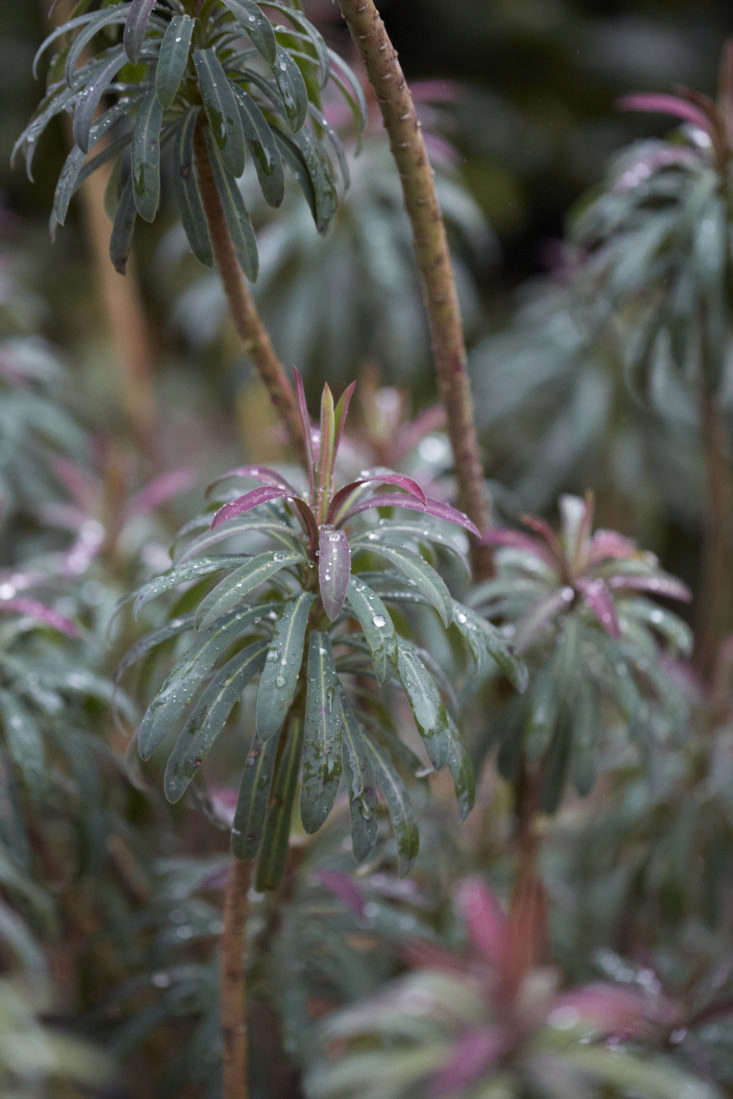We think of the spring greens of spurge as heralds of a new season, but there are many evergreen varieties that have been keeping the show on the road all winter as well. While not all spurges are reliably hardy, they are reliably self-seeding, so a victim of frost is replaced by a selection of progeny. You just need to recognize when self-seeded plants have chosen a better spot than you might have.
Spurge’s horticultural name Euphorbia is easy to remember, sounding like “euphoric” (an emotion you will feel when it fills the garden in early spring).
Here are six of our favorite varieties of spurge.
Photography by Britt Willoughby Dyer, for Gardenista.
E. Characias Subsp. Wulfenii

Treading gingerly last month around designer and gardening writer Beth Chatto’s own back garden (which is mainly open to the public like the rest of the property), we noticed that self-seeded euphorbia has been given pride of place. One Mediterranean spurge grows against the house, naturally splaying to reflect the shape of a trained rose (above). Another grows in front of a Buddleia that has been espaliered against a wall; surely a pairing of happy accidents.
Before the sap starts to rise in Mediterranean spurge, overwintering flowering bracts draw attention in a gravel garden. This is the time to enjoy their self-determining stems and elegantly drooping flower heads. Hardy to USDA zone 8a.
Euphorbia Myrsinites

Resembling a succulent in winter, ground-hugging E. myrsinites flowers from April through to the middle of summer. Grow this spurge where you can see it, at the front of a gravel garden, and ideally near your back door.
Euphorbia Rigida

Like a larger, more upright version of Euphorbia myrsinites, E. rigida is a structural evergreen, with flowers that begin to glow in February. Its hardiness, like that of Mediterranean spurge, does not have a cast iron guarantee in the US but it is gently self-seeding.
Euphorbia x Martinii

For arresting color, the glaucous palette of Euphorbia x martinii will give you something to look at in winter before it bursts into lime green flower in spring. In other words, it looks good for most of the year.

Euphorbia Amygdaloides Var. Robbiae

Not all spurges hanker after a Mediterranean climate; some are better suited to a woodland situation, such as Euphorbia amygdaloides var. robbiae. Its spreading nature integrates it into a tapestry of ground cover ,such as this one (shown). It is an excellent solution for dry shade.
Euphorbia characias ‘Portuguese Velvet’

E. characias ‘Portuguese Velvet’ prefers shelter and sun and brings an idea of sunnier places in its looks alone. When the flowers open they reveal dark eyes. When it is less wet, the leaves are soft and fuzzy.

See more growing tips in Spurges: A Field Guide to Planting, Care & Design and for companion plants, see Roses: A Field Guide and Daffodils 101. For more inspiration:
- Euphoric Over Euphorbia: 5 Perennials Every Garden Needs
- A Rich Seam: Quarry Gardening at the Chelsea Flower Show
- Menorcan Muse: Lessons from the Labyrinth in an Ancient Quarry












Have a Question or Comment About This Post?
Join the conversation (0)